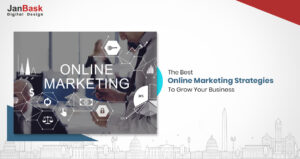

Can you recognize these brands without even their names but by just seeing their logos, taglines, or some visual ads? Of course, you can. The golden yellow arches of McDonald’s, the famous tagline of Nike, or even the tricolor of Pepsi, all these brands are what we have positioned so well in our memory. And we all know McDonald’s is more than a burger giant, Nike more than a sports shoe company, and Pepsi more than a fizz drink for us. How come, you must be pondering? One of the major reasons why these brands are bigger than they are is the emotional connection they built or the strong digital marketing practices they keep getting heightened at. Readers, this is the power of true business branding.
But What is Business Branding?
Jeff Bezos once famously said, “Your brand is what other people say about you when you’re not in the room.” And that’s what branding is, folks. Business Branding is the strong, positive perception that your customer has about your company or its product. And to brand your business isn’t a concept solely owned by large companies with huge budgets. If you own a business, even a small business, then you have a brand and the obligation to know how to brand your business online. But you don’t need an Apple-sized budget to effectively and successfully brand your business. So what do you need then? How do you brand your business name on a shoe-string budget or even free of cost?
Whether you’re a small business online or offline, just started a new venture, or even if you’re an established business (no loss in re-brushing your knowledge, right?) This blog is exactly going to tell you how to brand your business, discuss some amazing business branding tips for small businesses, and even will share a checklist for essential elements to get the best way to brand your business without blowing your budget!
Ready? Let’s dig in!
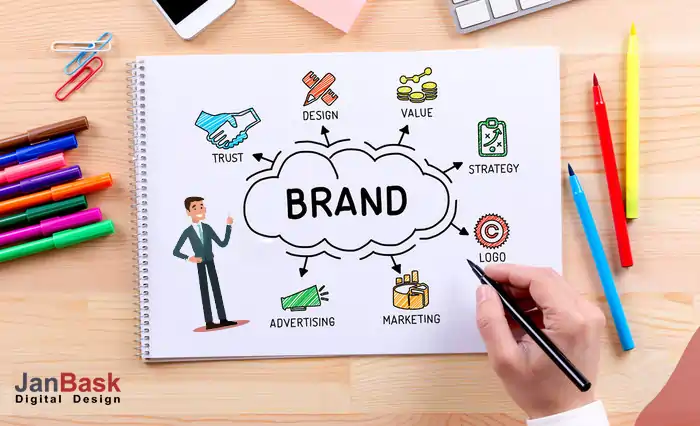
Your brand is the foundation on which you build your business and we all know what happens to buildings with weak foundations. They struggle to stand strong amidst storms and eventually collapse. But business branding is the block of bricks that will forever give that extra strength to hold your ground. As mentioned earlier, understanding how to brand your business is all about the way you want your customers to perceive you. You use certain elements like logo, tagline, consistent theme, or voice throughout all marketing communications to not only create your own distinct image in the minds of your customers (existing as well as potential) but also to help you shape your customers’ expectations. This develops a bond that goes beyond the buying-selling relationship and eventually helps you change how others perceive your image & credibility.
Branding your business online and branding it offline are two different concepts. Branding in-store is more about experiential perception as buyers come and pick things according to how they see or like your products. Online branding experience is quite a two-dimensional scenario with a customer’s experience based entirely on how you display the content, product, or service digitally. But what binds these two is your consistency in imagery, logos, and brand messaging. So how do you brand your business, exactly?
We have already discussed how branding your business gives you an edge over your competitors and earns you the badge of a reliable and credible business in their eyes but it does more than that. Branding gives you:
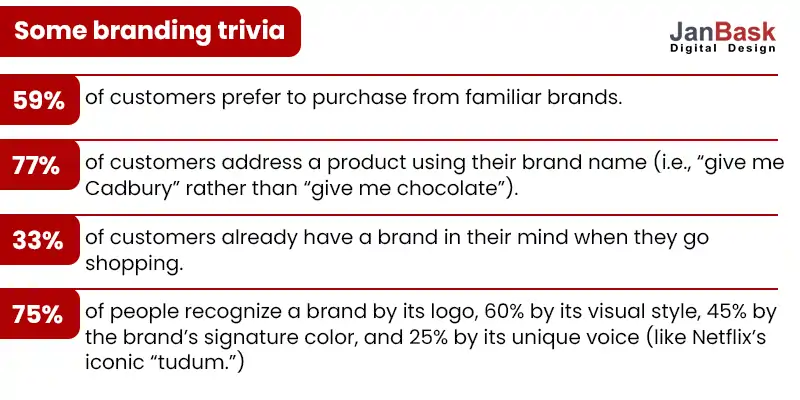
Let’s take a look at the super 7 business branding tips for small businesses, established, or even a startup that will help you take your business to the next level. Here’s to know how to brand your business:
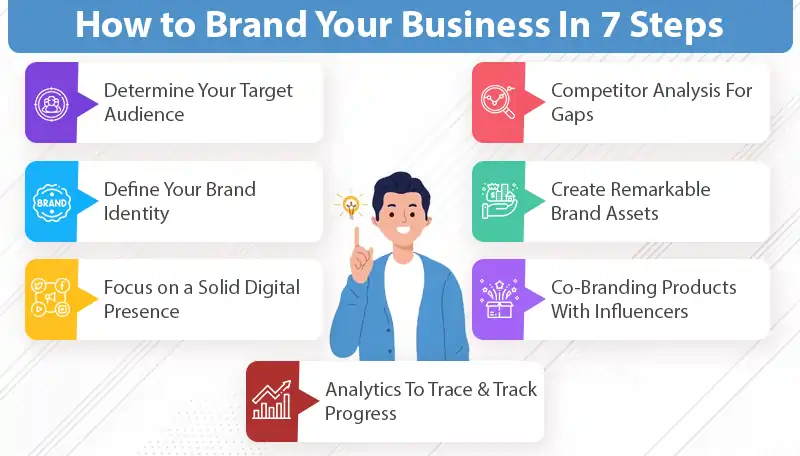
Knowing who your set of target audience is that you want to engage with and wanting them to buy or make them aware of your products or services is an essential step to creating solid branding for your business. Once you know who, what or where your audience is, you can perform many critical elements like keyword search correctly and find marketing opportunities that not just boost traffic but also drive user engagement, online visibility, and crazy revenue. Follow these key elements to select a target audience:
Researching about your competitors and what they are doing for branding not only helps you see what’s currently working but also gives you an understanding of what you are not doing and what your branding efforts are missing. So if there’s a brand that inspires or draws you to them (if you don’t have such a brand but you do have competitors, so look at them from the perspective of a customer) then identify the branding elements and try to either incorporate the same or even better, put your own unique twist to give your business an edge over them. Follow these key points to do a competitive competitor’s analysis:
Brand identity is more than a few colors, a theme, or a logo slapped together, it’s a crucial element if you're planning to set your brand apart from your competitors. So work on creating a personality that your customer is not only able to define but also recognize easily. It’s an amalgamation of both the Ws of your brand and the brand personality.
Your brand assets are a combination of color theme, tagline or jingle, font, logo or the kind of layout you’re running consistently across channels and therefore helping your customer feel connected to you or recognize you. Generally, your brand assets can be categorized into two types, namely:
a. Visuals:
To get completely professional and appealing visuals for your brand, explore our graphic designing services!

b. Voice:
We live in a technology-driven world and nothing is done without a quick search on the internet with 4.54 billion active internet users. So you can imagine if you are not online, your business is missing a lot. Your brand’s digital presence runs across websites and social media handles that you control and content that you can't such as online reviews or feedback. So to ensure you have a strong online presence through both, follow these steps:
With the help of influencer partnerships, you not only share a wider audience but also enjoy the expertise and knowledge of both parties, eventually reaching out to your prospects with better content. You can either partner with a fellow brand or influencers with a good following and expertise in your niche. In order to find the right influencers for your brand, remember these points:
You cannot progress ahead if you don’t know what is working for you and whatnot. Having a branding strategy is great but not measuring its progress would be a cardinal sin. You should go for a data-driven tracking approach to evaluate how branding your business is working for you. Tracking and tracing your campaigns or strategies not only help you know what is bringing results and what not but also help you avoid wasting your budget and efforts. The metrics you measure will depend on your campaign goals but there are various analytics tools and techniques that enable you to do brand tracking & progress. It can be on your website, via social media platforms, or any other place you are digitally present. So use marketing analytics tools like website Visitor Data, Google Analytics, Social Media Insights, or even brand awareness surveys to know whether you’re getting the desired result or not.
Now you know what are the ways to brand your business, now let’s talk about the 9 important elements needed to lead a successful brand!
Now you know business branding tips for small businesses or established businesses, so now let’s shift focus on knowing the 9 key elements of branding your business that you need to cross-check while you work on how to brand your business.
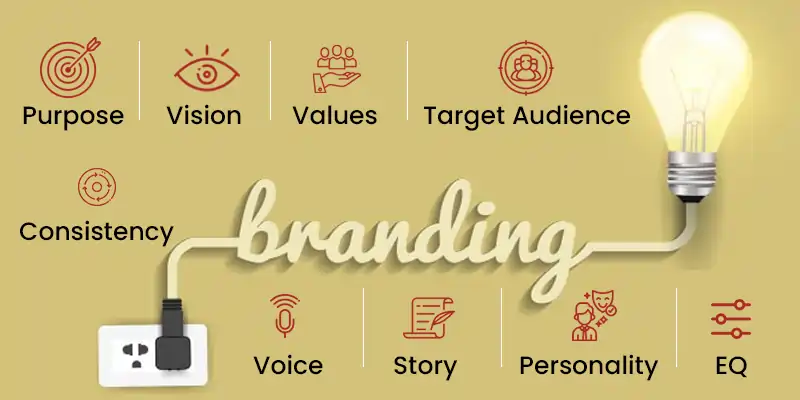
It’s the “Why” behind your business activities other than—making profits—that you need to be clear about so that you can foster connection with your team, and audience, grow & get better ROIs.
It’s like a roadmap for your business that gives you an overview of where your business is going or where you want it to go so that you can plan your resources, strategy, and efforts accordingly.
It’s about what your business stands for in the world, so define your core value and create a culture that lets people see what you believe in and therefore you can rally their support.
Your audience acts as the core spine to brand your business name or value so get to know them so well that you can resolve their pain points & fulfill their want lists with relevant solutions.
It’s about how you want your brand or product to come across, so ensure you’re humanizing your brand, giving it a character as much as you can, in order to resonate with your audience.
Your brand voice forms your brand identity through tone, style, and the language of the way you communicate with your customers. It’s what connects them with you, makes them feel emotions, and inspiration & empowers them to stay loyal to you & even advocate for you.
You cannot be a faceless entity, you need to connect with audiences, pull on their heartstrings, and engage with them on a much deeper level. That’s what a brand story does. It’s the essence of your brand or business conveyed in a way that moves your prospects emotionally & imprints your brand name into their memories.
Whatever image, personality, or tone you want to communicate, ensure that it's consistent throughout all marketing channels; from social media to in-person contact.
What your customer feels about you is sometimes more important than what they think about you. If you manage to connect with them on a deeper level, then not only do you gain brand loyalty but also brand advocacy from them. This helps you not only stay relevant to your customers but also broadens your customer base.
In today’s online world, your competition is no longer a store or shop across the street, it might be miles and miles away but if they know their branding and marketing tactics, they will steal your thunder. So stop them from stealing the spotlight from you and create your own mark in the oceans of big or small businesses by keeping your branding business strategy strong.
We saw how if you properly and effectively use the best way to brand your business name, you will not only increase your lead generation, sales, conversion, and customer loyalty but will also take your business to the next level.
Hopefully, this blog on how to brand your business online has helped you see that you don’t need a huge bank balance for branding your business. All you need is a little creative streak, passion & dedication to always serve right, and some old-fashioned hard words (both offline & online), and voila your brand will become more recognizable, your trust equity will improve exponentially and so will your revenue streams.
So what are you waiting for? Go, get out there and get on branding your business!
Is there anything else you’d like to know about branding your business that we missed in the blog? Let us know in the comment section below!
You can do business branding on social media by:
You can do business branding on social media by:
To do business branding on Facebook:

Leave a Reply